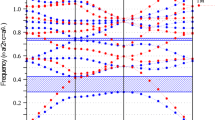Abstract
In this study, the design and simulation of an 18-channel demultiplexer based on resonant cavities in 2D photonic crystals is proposed. The lattice shape of silicon rods used in this structure is square. To have a reasonable percent transmittance from the input waveguide to resonant cavities, we have used point and linear defects, changing the radius of resonant cavities and adjusting the distance of the dielectric rods around the cavities. The main work of choosing the wavelength is performed by the resonant cavities. Due to a large number of output channels and long distances of the waveguides, the power reflector is used to compensate for the power losses in the waveguide path. The amount of the proposed structure’s percentage transmittance is between 90 and 100% and the quality factor is 5383 in the best case. The least bandwidth of the output signal spectra is 0.29 nm, and the amount of crosstalk between the output channels is from − 10 to − 62 dB. The overall dimensions of the proposed structure are 1069µm2. One of the essential applications of the proposed demultiplexer structure is in WDM communication systems.









Similar content being viewed by others
Availability of Data and Materials
The data and material are available within the manuscript.
Code Availability
Not applicable.
References
Mohammadi M, Fallahi V, Seifouri M (2020) Optimization and performance analysis of all-optical compact 4 and 5-channel demultiplexers based on 2D PC ring resonators for applications in advanced optical communication systems. Silicon 1–11
Sani MH, Khosroabadi S, Talebiyan R (2019) Ultra-narrow band of filter and 6-channel demultiplexer based on Nano-cavity resonance. 3rd International Conference on Electrical Engineering, Mechanical Engineering and Computer Engineering Science. COI: EMECCONF03_052
Liao Q-H, Fan H-M, Chen S-W, Wang T-B, Yu T-B, Huang Y-Z (2014) The design of large separating angle ultracompact wavelength division demultiplexer based on photonic crystal ring resonators. Opt Commun 331:160–164
Sani MH, Khosroabadi S, Shokouhmand A (2019) A novel design for 2-bit optical analog to digital (A/D) converter based on nonlinear ring resonators in the photonic crystal structure. Opt Commun
Sani MH, Khosroabadi S, Nasserian M (2020) High performance of an all-optical two-bit analog-to-digital converter based on Kerr effect nonlinear nanocavities. Appl Opt 59, 1049–1057
Sani MH et al (2020) A novel all-optical sensor design based on a tunable resonant nanocavity in photonic crystal microstructure applicable in MEMS accelerometers. Photonic Sensors 1–15
Sani MH, Khosroabadi S (2020) A novel design and analysis of high-sensitivity biosensor based on nano-cavity for detection of blood component, diabetes, cancer and glucose concentration. IEEE Sens J 20, 7161–7168
Sani MH, Tabrizi AA, Saghaei H, Karimzadeh R (2020) An ultrafast all–optical half adder using nonlinear ring resonators in photonic crystal microstructure. Opt Quant Electron 52, 107
Sami P, Shen C, Sani MH (2020) Ultra-fast all optical half-adder realized by combining AND/XOR logical gates using a nonlinear nanoring resonator. Appl Opt Vol. 59, No. 22
Naghizade S, Sattari-Esfahlan SM (2017) Excellent quality factor ultra-compact optical communication filter on ringshaped cavity. J Opt Commun
Sani MH, Ghanbari A, Saghaei H (2020) An ultra‑narrowband all‑optical filter based on the resonant cavities in rod‑based photonic crystal microstructure. Opt Quant Electron
Naghizade S, Sattari-Esfahlan SM (2017) An optical five channel demultiplexer-based simple photonic crystal ring resonator for WDM applications. J Opt Commun
Alipour-Banaei H, Mehdizadeh F, HassangholizadehKashtiban M (2013) A novel proposal for all optical PhC based demultiplexers suitable for DWDM applications. Opt Quant Electron 45:1063–1075
Zhang X, Liao Q, Yu T, Liu N, Huang Y (2012) Novel ultra-compact wavelength division demultiplexer based on photonic band gap. Opt Commun 285:274–276
Venkatachalam K, Sriram Kumar D, Robinson S (2016) Investigation on 2D photonic crystal-based eight-channel wavelength-division demultiplexer. Photon Netw Commun 34:100–110
Naghizade S, Sattari-Esfahlan SM (2020) Tunable high performance 16-channel demultiplexer on 2D photonic crystal ring resonator operating at telecom wavelengths. J Opt Commun 41(3):249–256
Talebzadeh R, Soroosh M (2015) High quality complete coupling 4-channel demultiplexer based on photonic crystal ring resonators. Opt Electron Adv Mater 9(1-2):5-9
Birjandi MAM, Rakhshani MR (2014) A new design of tunable four port wavelength demultiplexer by photonic crystals ring resonators. Optik 124:5923–5926
Rakhshani MR, Birjandi MAM (2013) Design and simulation of wavelength demultiplexer based on heterostructure photonic crystals ring resonators. Physica E 50:97–101
Venkatachalam K, Sriram Kumar D, Robinson S (2016) Investigation on modified quasi-square PCRR based demultiplexer for WDM applications. Opt Quant Electron 48:393
Fallahi V, Mohammadi M, Seifouri M (2019) Design of two 8-channel optical demultiplexers using 2D photonic crystal homogeneous ring resonators. Fiber Integr Opt 38(5):271–284
Naqizadeh et al (2018) proposed a structure that includes 16 output channels; a quality factor of 4417 in the worst case and a bandwidth of 0.3 nm in the best case
Author information
Authors and Affiliations
Contributions
All the works in this paper (study conception and design, material preparation, data collection and analysis) have been done together by Mojtaba Hosseinzadeh Sani and Saeed Khosroabadi. All authors read and approved the final manuscript.
Corresponding author
Ethics declarations
Ethics Approval
The authors declare that they have no known competing financial interests or personal relationships that could have appeared to influence the work reported in this paper.
Consent to Participate
All authors voluntarily agree to participate in this research study.
Consent for Publication
All authors have endorsed the publication of this research.
Conflict of Interest
The authors declare no competing interests.
Additional information
Publisher's Note
Springer Nature remains neutral with regard to jurisdictional claims in published maps and institutional affiliations.
Rights and permissions
About this article
Cite this article
Sani, M.H., Khosroabadi, S. A Novel Design of High-Quality 18-Channels Demultiplexer Based on Resonance Nanocavities. Plasmonics 17, 1403–1410 (2022). https://doi.org/10.1007/s11468-022-01623-w
Received:
Accepted:
Published:
Issue Date:
DOI: https://doi.org/10.1007/s11468-022-01623-w




